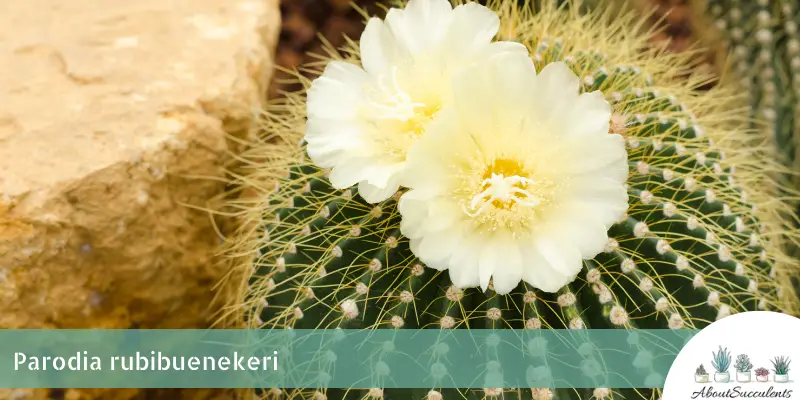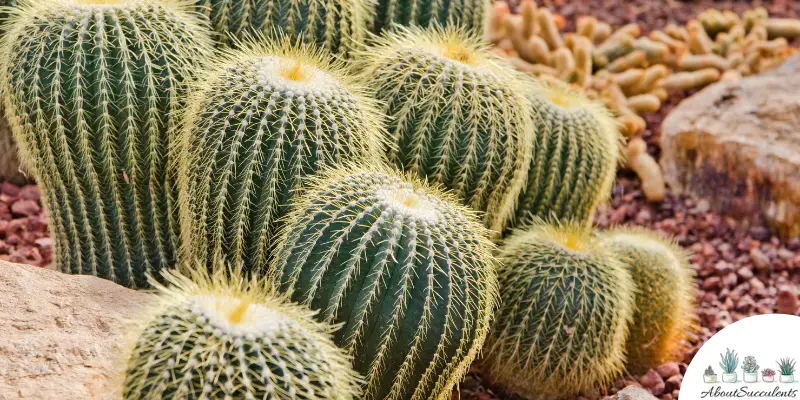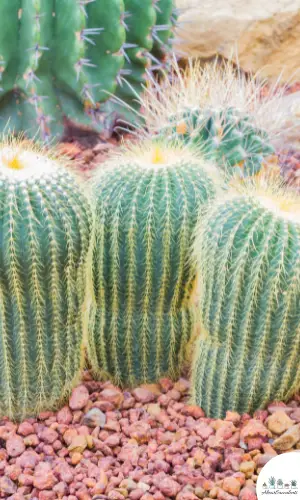
Parodia rudibuenekeri is a striking succulent that gifts you with small, clustering offsets. In the summertime, you’ll be welcoming warmer temperatures with small flowers that range in color from pale to bright yellow and white.
Parodia is a genus of flowering plants that are cacti and which are commonly found in Brazil, Argentina, Paraguay, Colombia, Bolivia, and Peru. It’s a member of the Cactaceae family.
Rudibuenekeri is a small barrel cactus that doesn’t grow more than 8-inches (20.32cm) in height and 2-inches (5.08cm) in width.
Similar to other species, this cactus is covered in long, erect, and white-colored soft spines that give the succulent a fuzzy and glassy appearance. The spines are actually soft to the touch.
Its stem has a cylindrical shape that when fully grown can reach 7-inches (20cm) in height and 1.96-inches (5cm) in width.
General Information
Also known as: Rubibuenekeri.
Plant Family: Cactaceae
Origin: Brazil, Argentina, Paraguay, Colombia, Bolivia, and Peru
Height: 8-inches (20.32cm)
Exposure: 6 hours to partial to full sun per day.
Water Needs: Drought-tolerant; use the “Soak and Dry” method for watering
Soil Type: Cactus soil or 2 parts potting soil mixed with 1 part perlite, pumice, coarse sand, and lava rock for improved drainage.
Soil pH: 5.0 to 6.5
How to Grow and Care for Parodia Rubibuenekeri

Parodia Rubibuenekeri is popularly displayed in outdoor gardens to add more height and texture. However, you can also grow it indoors as a houseplant. This is advisable if you live in a zone where the temperature can go lower than 30° F (-1.1° C) because Rubibuenekeri isn’t a cold-hardy succulent.
Whether you decide to plant Parodia Rubibuenekeri outdoors or indoors, you won’t have any problems growing and caring for it.
Sunlight
The best location for Parodia Rubibuenekeri in an outdoor garden is an area where it can be assured of getting full to partial sunlight for up to 6 hours every day. Full sunlight is recommended as long as it’s from the morning sun.
Avoid exposing Rubibuenekeri to the afternoon sun because its rays can be intense enough to burn the succulent.
Inside your home, look for a window that brings in up to 6 hours of sunlight. Getting enough sun might be a challenge during wintertime. The best solution would be to place Parodia Rubibuenekeri under a Grow Light.
Watering

Like a cactus, Parodia Rubibuenekeri stores plenty of water. It can survive harsh drought conditions and thrive without water for weeks.
If you try to grow Parodia Rubibuenekeri like a typical plant and water it every day, you will fast-track its demise.
Since succulent plants store water, you don’t have to water them frequently. Doing so will keep its soil in a moistened state for a long time and expose the roots to a greater risk of rotting. In addition, wet soil becomes the ideal breeding ground for bacteria and fungi.
The simple rule when it comes to watering succulent plants is to water only when the soil is 100% dry. This is called the “Soak and Dry” method.
Check the soil’s dryness by inserting your finger or a stick an inch deep. If the soil or the end of the stick feels dry, prepare to give the soil a good soaking. Yes, water the soil and never the plant directly.
During the growing season of spring or summer, you might be watering Rubibuenekeri every 10 days. Expect the watering schedule to be less frequent – maybe only once a month – during winter.
Pot and Soil
Choose unglazed ceramic or terracotta as the type of pot for Parodia Rubibuenekeri. These types of pots are highly absorbent of moisture and will help dry out the soil faster.
Anticipate the growth of your succulent plant and buy a pot that’s slightly larger than its base to allow the roots to grow freely and provide better soil aeration.
The last thing you have to look for in a pot for Rubibuenekeri is that it must have a drain hole at the bottom so that excess water can drip out from the soil.
You can plant Rubibuenekeri in cactus soil or create your own by mixing 2 parts of potting soil with 1 part of gritty materials. Among the best gritty materials to use are perlite, pumice, coarse sand, and lava rocks.
How to Propagate Parodia Rubibuenekeri
Parodia Rubibuenekeri produces offsets that grow on its stems and can be used for propagation. However, you can also propagate the species through stem cuttings and leaves.
Offsets Method
Step 1: Use a sharpened and sterilized knife to cut off the offsets from the stem. Choose offsets that are large or mature and make sure the roots remain intact.
Step 2: Allow the offsets to form calluses over a period of 2 to 4 days.
Step 3: Plant the offsets in well-draining soil.
Step 4: Lightly water the soil and place the pot near a window that gets up to 6 hours of partial sunlight.
Step 5: Check the roots. If the roots have taken firm hold in the soil, water the soil only when it’s gone completely dry.
Stem Cuttings Method
Step 1: Cut a small section of the stem with a sterilized knife.
Step 2: Let the cuttings develop hard calluses. This will take 2 to 4 days.
Step 3: Place the cuttings on well-draining soil.
Step 4: Water the soil a bit to keep it moist then position the pot in an area that receives up to 6 hours of partial sunlight per day.
Step 5: If the root system has formed, switch to the “Soak and Dry” method of watering.
Leaves Method
Step 1: Perform a clean twist and pull to remove a leaf from the stem. Make sure no part of the leaf remains on the stem to ensure successful propagation.
Step 2: Place the leaves in a dry area where they can grow calluses over 2 to 4 days.
Step 3: Place the calloused leaves on top of well-draining soil.
Step 4: Spray the soil with water to keep it moist. Move the pot to an area that regularly gets 6 hours of sun.
Step 5: If the roots are present, water the soil when it’s 100% dry.
Frequently Asked Questions
Is Parodia Rubibuenekeri Toxic to Cats and Dogs?
No. Parodia Rubibuenekeri doesn’t appear on the list of plants that are toxic to cats and dogs found on the website of the American Society for the Prevention of Cruelty to Animals (ASPCA).
Why Is My Parodia Rubibuenekeri Dying?
Parodia Rubibuenekeri can survive a month without water but if you give it more than what it needs, you’ll kill it. Also, watch out for pests that will infest and infect your succulent plant.
Your beautiful cactus won’t die if you act right away. Even if you don’t have to fuss over Rubibuenekeri, be on the lookout for signs of infection.
Overwatering
Overwatering leads to root rot and this creates an opportunity for fungi to enter the plant and spread infection. You’ll know this to be the case if you see yellow-brown spots on the cactus.
When you see these kinds of spots, remove them immediately with a sterilized knife to prevent the infection from spreading further.
After sterilizing the knife with 70% isopropyl alcohol, uproot the plant from the soil. Look for roots that have turned rotten and cut them off. Allow Rubibuenekeri 1 to 2 days to recover and dry out.
Fill a new pot with fresh cactus soil and replant Rubibuenekeri. Give the succulent 2 to 3 days to get used to the pot and soil before watering.
Pest Infestation
Pests leave clues on your plant that will let you know they are there. These clues are whitish, cotton-like substances that have a waxy texture. Remove these substances by using a cotton ball soaked in 70% isopropyl alcohol.
To keep pests away from your succulents, spray them with diluted neem oil. Pests love Rubibuenekeri because these insects find the sap and the leaves delicious.
Yes. Parodia Rubibuenekeri will produce small flowers that range in color from pale to bright yellow and white in summer.
Last Updated on June 15, 2022 by Sofia Lara